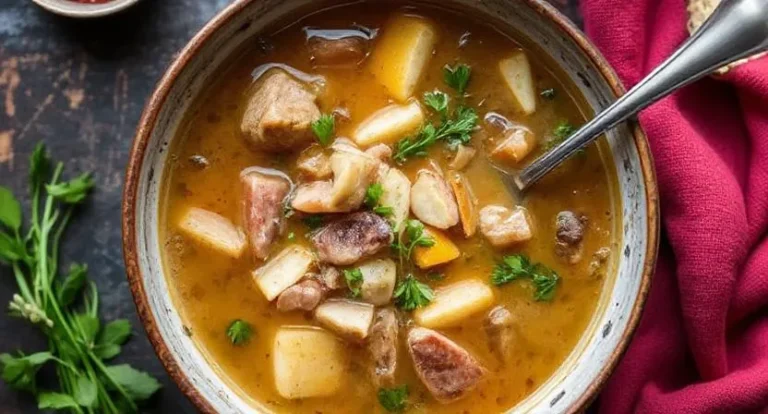Cumberland Sausage
Cumberland sausage stands as a revered jewel of English gastronomy, famed for its captivating coil shape and robust seasoning. Hailing from the historic county of Cumberland in the northwest reaches of England, this sausage carries with it centuries of culinary tradition. Crafted traditionally from prime cuts of pork and a medley of aromatic spices, every bite of Cumberland sausage is an explosion of hearty, rustic flavor. Its signature spiral form distinguishes it instantly from the run-of-the-mill sausages that populate butcher counters worldwide. Whether you’re a kitchen virtuoso or an enthusiastic beginner, creating your own Cumberland sausage is an experience every pork aficionado should savor. This guide offers a detailed blueprint to mastering this quintessential dish—a sensational addition to breakfast feasts, backyard barbecues, or cozy home-cooked suppers.

What Makes Cumberland Sausage Special
Cumberland sausage is far from your average sausage. Several defining elements set it apart. Chief among them is its iconic coiled shape, traditionally wound into generous loops—a sight rarely encountered with other varieties. This distinct form not only ensures even cooking but lends the sausage an unmistakably British allure.
The seasoning is equally remarkable. Unlike standard sausages, Cumberland bursts with a symphony of black and white pepper, sage, thyme, nutmeg, and a whisper of cayenne. The resulting taste is a warming, aromatic celebration that amplifies the pork’s succulence. Additionally, traditional Cumberland sausage boasts a coarse, chunky texture, thanks to the hand-chopped meat—offering a rustic mouthfeel unlike the fine grind of its counterparts.
What You’ll Need for Cumberland Sausage
Ingredients
- 500g pork shoulder, coarsely minced
- 150g pork belly or back fat, finely minced
- 1 teaspoon salt
- 1 teaspoon ground black pepper
- ½ teaspoon white pepper
- ½ teaspoon ground nutmeg
- ½ teaspoon cayenne pepper
- ½ teaspoon dried sage
- ½ teaspoon dried thyme
- 50ml chilled water
- Natural hog casings (soaked and rinsed)

How to Make Cumberland Sausage
Step 1: Preparation
Sanitize all tools and surfaces thoroughly. Soak hog casings in fresh water for 30 minutes, then rinse to wash away residual salt.
Step 2: Mix the Ingredients
In a sizable bowl, combine pork shoulder and pork belly with all the spices and herbs. Work the mixture by hand until evenly blended and fragrant.
Step 3: Add the Water
Gradually pour chilled water into the seasoned meat, mixing steadily. This process slightly emulsifies the blend, making it smoother to stuff into casings.
Step 4: Stuff the Sausage
Thread the hog casing onto the nozzle of a sausage stuffer. Gently fill, taking care to avoid overpacking. As the casing fills, naturally encourage it into a coil. Tie off the ends securely.
Step 5: Cooking the Sausage
Preheat a grill or frying pan to medium heat. Lightly oil the surface and place the coiled sausage flat. Cook for 10–15 minutes on each side, ensuring the internal temperature reaches 70°C (160°F). Alternatively, bake at 180°C (350°F) for 25–30 minutes, flipping once midway for even browning.
Times, Calories, and Servings
- Preparation Time: 30 minutes
- Cooking Time: 25–30 minutes
- Total Time: Approximately 1 hour
- Calories: ~250 calories per serving
- Servings: Approximately 4 servings

How to Store Cumberland Sausage
Cool any leftover sausages completely before refrigerating. Store in an airtight container for up to 3 days. To freeze, arrange sausages flat on a tray first to prevent sticking, then transfer to a freezer-safe container. They’ll keep well for up to 2 months. When ready to enjoy, thaw overnight in the refrigerator and reheat thoroughly.
Tips for a Perfect Cumberland Sausage
- Quality Meat: Choose high-grade pork with sufficient fat (around 80% meat to 20% fat) for that essential juiciness.
- Spices: Customize the spice blend to your liking—don’t shy away from boosting the cayenne if you crave a bolder kick.
- Casings: Always opt for natural hog casings for authenticity; soak well before use.
- Even Stuffing: Fill casings uniformly to prevent air pockets, which can cause bursting during cooking.
- Gentle Cooking: Cook slowly over moderate heat to achieve caramelized exteriors and tender interiors.
The Best Variations of Cumberland Sausage
- Gluten-Free: Ensure spices and casings are certified gluten-free; substitute breadcrumbs if needed with gluten-free options.
- Vegan/Vegetarian: Try inventive plant-based mixtures of lentils, mushrooms, and aromatic herbs to mimic the classic taste and texture.
- International Flavors: Fuse traditions by adding fennel seeds for an Italian twist or cumin for a spicy Mexican flair.
- Spicy Version: Crank up the heat by introducing chili flakes or smoked paprika into the seasoning mix.
What to Serve with Cumberland Sausage
- Mashed Potatoes: Velvety mashed potatoes offer the ultimate pairing for the sausages’ bold flavors.
- Onion Gravy: Pour rich, silky onion gravy over your sausage coil for an indulgent British classic.
- Salad: A crisp, tangy salad—perhaps with apple and walnut—balances the richness beautifully.
- Beer or Ale: A robust ale or crisp lager enhances the earthy spices of the sausage wonderfully.
- Roasted Vegetables: Serve alongside roasted carrots, parsnips, or asparagus for a colorful, wholesome plate.

Frequently Asked Questions
What sets Cumberland sausage apart from other sausages?
Its coiled form, rustic texture, and peppery-herbal seasoning distinguish Cumberland sausage from the standard varieties.
Can I freeze raw Cumberland sausage?
Absolutely. Just ensure it’s properly vacuum-sealed or tightly packed to maintain its freshness before freezing.
Why do my sausages burst during cooking?
Overstuffing or high heat often causes bursting. Cook gently and resist pricking the sausage during cooking.
How long should I cook Cumberland sausage?
Generally, it takes around 15–20 minutes over medium heat. Always ensure there’s no pinkness inside before serving.
What’s the ideal meat-to-fat ratio?
Aim for an 80:20 balance of meat to fat for maximum flavor and juiciness.
Conclusion
Cumberland sausage is not merely food—it’s a celebration of flavor, history, and home-cooked tradition. Its rustic texture and warmly spiced profile make it an irresistible centerpiece, whether you stick to time-honored recipes or infuse a modern twist. Once mastered, it promises to be a perennial favorite, filling kitchens with irresistible aromas and hungry anticipation. Here’s to perfecting the art of crafting your very own Cumberland sausages—and to the delightful meals that follow.






